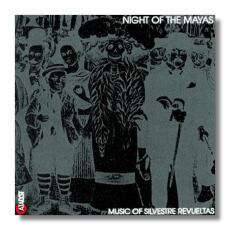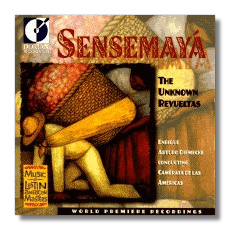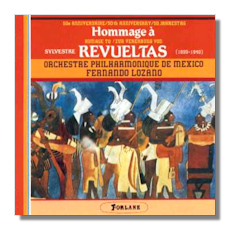
The Internet's Premier Classical Music Source
Related Links
- Revueltas Reviews
- Latest Reviews
- More Reviews
-
By Composer
-
Collections
DVD & Blu-ray
Books
Concert Reviews
Articles/Interviews
Software
Audio
Search Amazon
Recommended Links
Site News
 CD Review
CD Review
Silvestre Revueltas

Night of the Mayas
- Homenaje a Federico Garcia Lorca
- Sensemayá
- Ocho X Radio
- Toccata
- Alancias
- La Noche de los Mayas
New Philharmonia Orchestra/Eduardo Mata
London Sinfonietta/David Atherton
Orquesta Sinfonica de Jalapa/Luis Herrera de la Fuente
Catalyst 09026-62672-2


Sensemayá – The Unknown Silvestre Revueltas
- Troka
- Cuauhnáhuac
- Five Songs
- Enscenas Infantiles
- Cuatro Pequeños Trozos
- El Afilador
- Parián
- Sensemayá
Camerata de las Américas/ Enrique Arturo Diemecke
Cuarteto Latinoamericano
Dorian DOR-90244


Homage à Silvestre Revueltas
- Sensemayá
- Homenaje a Federico Garcia Lorca
- Danse
- Deuil
- Son
- La Noche de los Mayas
- La Noche de Yucatan
- Redes
Orchestre Philharmonique de Mexico/Fernando Lozano
Forlane UCD16614
"[Revueltas'] music not only appeals to the ears and intellect, it grabs the listener physically, and does not let go until the end of the piece."
– Peter Garland, In Search of Silvestre Revueltas
Discoveries don't come much better than this. With these and other recent releases of the music of Mexican composer Silvestre Revueltas (1899-1940), a long-neglected composer is finally getting the recognition due him. And why shouldn't he? His music is extraordinarily inventive. It is modernistic, yet steeped in folklore. Within the same piece, there can be irony and tenderness, lyricism and drama, calm shores and blustery volcanoes. A bolt of furious rhythm can strike anywhere, anytime.
Plagued by alcoholism in the last ten years of his life, Revueltas wasn't a prolific composer. These three albums have accumulated most of his representative pieces and where they overlap, the interpretations are vastly different. For example, Revueltas: The Night of the Mayas and Homage a Silvestre Revueltas both feature Homenaje à Federico García Lorca. Federico Garcia Lorca was a Spanish poet murdered by the fascists during the Spanish Civil War. This stunner begins with a mournful solo trumpet and suddenly breaks into intensely rhythmic dissonance, conveying collective sorrow, anger, confusion, and loss. Ultimately courage bursts through this brief piece, particularly in the coda, which becomes a wild dance with death. I'm reminded of the painter José Guadalupe Posada and his festive skeletons whirling about during Mexico's Day of the Dead. Both Eduardo Mata and Fernando Lozano skillfully conduct Homenaje à Federico García Lorca. Yet Lozano's interpretation (13'30" long) comes off as less of a whiz-bang show piece than Mata's (11" long). His pacing is more developed, the music breathes freer, the trumpet solos are more soulful.
I have never heard anything quite like Sensemayá. The tension in this piece, a programmatic interpretation of Nicolas Guillen's poem about a snake killing, builds sensuously. The influence of Maurice Ravel's Boléro and Béla Bartók's Music for Two Pianos, Percussion, and Orchestra is faintly evident, yet this work is more rhythmic, more visceral than either. Lozano constructs it so perfectly, the snake's slithering is almost palpable. Yet once again, Mata disappoints. He releases too much too soon. By the tenth bar, the rhythm is already too fast, the knot of tension loosens, and the drama deflates. Everything about Lozano's interpretation puts it a notch above Mata's: greater contrast between measures, more restrained and adept musicianship, more finely tuned caesuras. I'll discuss Diemecke's performance of the chamber ensemble version later in this review.
Created as music for a film of the same name, La noche de los Mayas is the closest Revueltas came to a full-fledged symphony. Had he lived the additional ten years he wished for, he might have composed symphonies that would have rivaled those of his colleague, Carlos Chavez. The third conductor, Luis Herrera de la Fuente, performs La noche de los Mayas with nearly as much sensitivity as Lozano, but succumbs to the temptation to render the Allegro at a fevered, show-stopping pitch. Although a fair rendition, it just misses capturing the epic sweep.
Lozano has taken a major step in popularizing Revueltas' work. And while his interpretations may be preferable, those of Mata and Herrera de la Fuente are still serviceable. Consider purchasing the Catalyst disc if you want to hear Revueltas' unsettling but fascinating early pieces. Ocho X Radio, Toccata, Alancias, and Planos are short forays into modernism, Revueltas testing his compositional wings. In Alancias, for example, he blends dissonance and disjunctive rhythms, fused with the energy of Mexican folk melodies. It is startling music, partly because Revueltas loves to thwart expectation. (Revueltas means "mischievous" in Spanish.) If it weren't written in 1932, it could almbst he aoparedy of Aaron Copland's El Salón México (1936). Planos shows the influence of Edgar Varèse, particularly his magnificently orchestrated Amériques (1922). Its notes form harsh, choppy angles, like shapes in a Georges Braque painting. Provocatively conducted by David Atherton, these transitional pieces are like carnival dark rides: first, the slow ascent uphill, then a gauntlet of demons and duendes. Atherton makes this music leap, writhe, and weave, resisting exotic effects like abrupt shifts in volume or tempo.
Conductor Eduardo Arturo Diemecke performs less well-known pieces by Revueltas. Even the famous title piece is the early chamber ensemble version, which is rarely played. Gone is the voluptuous orchestration of the later version of Sensemayá and in its place is a lean and quirky rendition. The sonorities are more strident and its development is swifter. The timing is 4'39", while Fernando Lozano's interpretation is 7'11". Most noticably, the tonal color appears thin and washed out. Unlike Arnold Schoenberg's chamber orchestration of Gustav Mahler's Das Lied von der Erde, this piece feels incomplete, like a first draft, a mere outline of the later version. It is fascinating to hear this curiosity, but only in the context of having heard the later version. Diemecke performs with fiery intensity although, as with Eduardo Mata, I question his tempo.
Five Songs range in tone from the charming and humorous to the chilling. Sung sensitively by soprano Lourdes Ambriz and baritone Jesús Suaste, the three animal songs remind me of Maurice Ravel's L'Enfant et les Sortilèges with their playfulness and cantankerous phrasings. The two songs by Nicolás Guillen have complex themes and subject matter (tension between the classes). The poignant duo, Caminando is downright spooky, with its deceptively melodic sweetness and shocking ending.
Many of the orchestral pieces show that Revueltas was a poet of miniatures. The whimsical Escenas Infantiles, sounds like a two-minute romp through a playroom, while Cuatro Pequeños Trozos offers an early set of brief string trios, melancholically performed by Cuarteto Latinoamericano. El Afilador, another early piece, is filled with deep loneliness. But the joyous Parián (for soprano, mixed chorus, and chamber ensemble) conveys the boisterous drama of the marketplace, using clever clashes between dissonance and traditional melodies, all expressed in three minutes.
I commend artistic director Roberto Kolb Neuhaus for his research that found these gems. They add more layers to our impressions of this complex composer.
Like his contemporary, the painter Diego Rivera, Revueltas splashes color onto a mural-sized canvas. And like Rivera, his later work embodies something larger than himself, soaring beyond the influences of his own country. Profoundly influenced by its time, Revueltas' work will endure well beyond it.
Copyright © 1998, Peter Bates



















